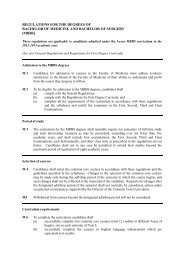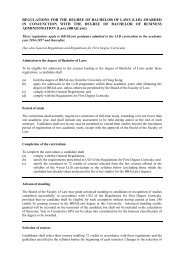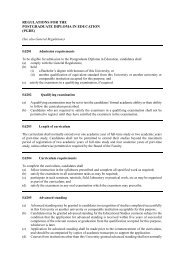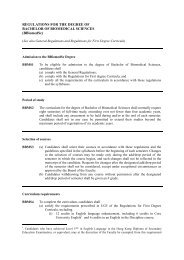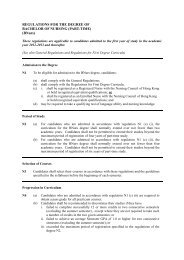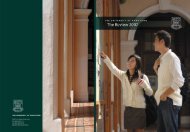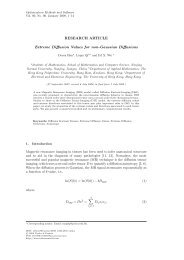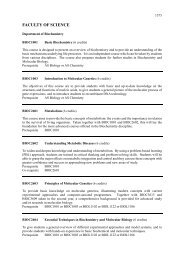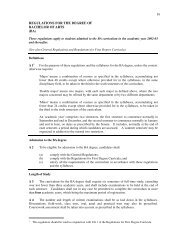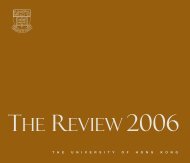Bachelor of Arts (BA) - The University of Hong Kong
Bachelor of Arts (BA) - The University of Hong Kong
Bachelor of Arts (BA) - The University of Hong Kong
Create successful ePaper yourself
Turn your PDF publications into a flip-book with our unique Google optimized e-Paper software.
197HIST2004.Twentieth-century China, Part II: from revolution to modernization, 1949 topresent (6 credits)(This course is also <strong>of</strong>fered to second and third year non-<strong>BA</strong> students for inter-Faculty broadeningpurposes.)This course examines the consolidation <strong>of</strong> Communist power, the dynamics and constraints <strong>of</strong>revolutionary ideology, and the PRC's quest for modernization and great-power status. Attention willbe drawn to the Chinese Communists' methods <strong>of</strong> thought and work, and to the historical forces <strong>of</strong>continuity and change.Assessment: 100% coursework.HIST2005.History <strong>of</strong> <strong>Hong</strong> <strong>Kong</strong>, Part I (6 credits)(This course is also <strong>of</strong>fered to second and third year non-<strong>BA</strong> students for inter-Faculty broadeningpurposes.)Beginning with the pre-British situation, the course proceeds to examine the establishment <strong>of</strong> colonialrule, the development <strong>of</strong> Chinese social institutions such as the Tung Wah Hospital, the emergence <strong>of</strong>Chinese revolutionaries led by Sun Yat-sen, the anti-colonial boycotts culminating in the general strike<strong>of</strong> 1925-26, and the events leading up to World War II. Throughout, emphasis is placed on thematic andinterpretive concerns.Assessment: 100% coursework.HIST2006.History <strong>of</strong> <strong>Hong</strong> <strong>Kong</strong>, Part II (6 credits)(This course is also <strong>of</strong>fered to second and third year non-<strong>BA</strong> students for inter-Faculty broadeningpurposes.)This course examines the extraordinary development <strong>of</strong> <strong>Hong</strong> <strong>Kong</strong> after World War II. <strong>Hong</strong> <strong>Kong</strong>'srelations with China, rapid industrialization in the 1950's and post-industrialization in the 1980's, theinterdependence <strong>of</strong> real estate and financial development, immigration and cultural identity, socialproblems and riotous disorders, contrasts between modernization and westernization are major thematicconcerns. Emphasis will be placed on developing interpretive understanding <strong>of</strong> historical events.Assessment: 100% coursework.HIST2008.Meiji Japan, 1868-1912 (6 credits)(This course is also <strong>of</strong>fered to second and third year non-<strong>BA</strong> students for inter-Faculty broadeningpurposes.)<strong>The</strong> Meiji leadership centralized Japan after centuries <strong>of</strong> decentralization. This course attempts toassess the quality <strong>of</strong> the leadership, identify the problems <strong>of</strong> centralization, analyze the effectiveness <strong>of</strong>the solutions, and appraise Japan's achievement at the end <strong>of</strong> the period especially in terms <strong>of</strong> itsinternational standing.Assessment: 100% coursework.HIST2009.Modern Japan since 1912 (6 credits)(This course is also <strong>of</strong>fered to second and third year non-<strong>BA</strong> students for inter-Faculty broadeningpurposes.)This course is a general survey <strong>of</strong> the domestic political, economic, and social history <strong>of</strong> Japan since1912. Some <strong>of</strong> the developments covered will be industrialization, changing systems <strong>of</strong> internationalrelations (including World War II and the subsequent Allied Occupation), and rapid political change andeconomic growth in the postwar era.Assessment: 100% coursework.



